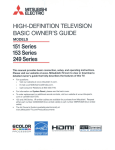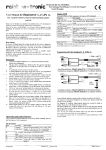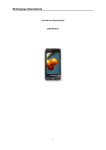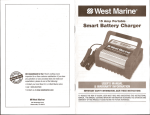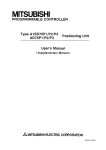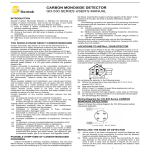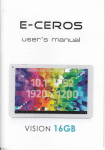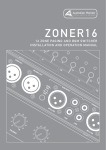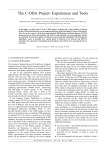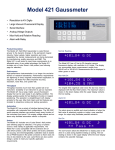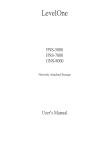Download In a word processing system
Transcript
United States Patent [191 Horn et al. v ADJUSTMENT WITH AUTOMATIC PAGINATION both of Austin, Tex. International Business Machines Corporation, Armonk, NY. Int. . . . .. . . . . . . . . . . . . . . . . .. ....... ...... .. G06F 9/00 [52] US. [58] Field of Search .............................. .. 364/200, 900 [56] Cl. Mountain View, CA 94043, “Changing the Page Lay out”, pp. 6-1-6-10. Primary Examiner—Thomas M. Heckler Attorney, Agent, or Firm-Douglas H. Lefeve Jun. 13, 1986 Cl.4 printing, Sept. 1984, Software Publishing Corporation, Assistant Examiner-John G. Mills [21] Appl. No.: 873,753 [51] Nov. 24, 1987 Layout”, pp. 7-1-7-9. PFS: Write User’s Manual, Barbara Langworthy, ?rst [75] Inventors: Gary R. Horn; Robert C. Mikelait, [22] Filed: 4,709,348 lishing Corporation, “Chapter 7. Changing the Page [S4] INTERACTIVE PAGE LENGTH [73] Assignee: Patent Number: Date of Patent: [1 l] [45] . . . . . . . . . . . .. 364/900 [57] ABSTRACT A comprehensive pagination facility is described which combines an automatic pagination function with an interactive paginate function. With this technique the References Cited operator is allowed to insert both Page End and Re U.S. PATENT DOCUMENTS quired Page End controls, although the automatic pagi 4,417,322 11/1983 4,498,150 2/1985 nation function makes page ending decisions during Berry eta]. ....................... .. 364/900 Gaudet et al. .................... .. 364/900 OTHER PUBLICATIONS IBM DispIayWrite 1 User’s Guide, Mar. 1984, Interna tional Business Machines Corporation, pp. 4-12, 4-13, 6-32, 6—38 and 6-39. IBM Writing Assistant, First Edition (May 1984) Inter national Business Machines Corporation, Software Pub 4 i both the creation and revision of text. The operator can then interactively paginate the document while being allowed to view each page ending decision and option ally accept the page break location or reposition the suggested page break location to a different line on the page. 7 Claims, 3 Drawing Figures a e e KEYBOARD DISPLAY DISKETTE MEMORY PRINTER ROM ADAPTER ADAPTER ADAPTER ADAPTER ADAPTER ADAPTER BL) 40; 445 lg 43 44 ans J 11 Z MICROPROCESSOR as (201' mil chur acteru Line Enter L‘ look M 1m follow ing chomcter line number 4 line spacing > last body in! lifnl - ring chm acm a Line Heed ' a r/ Foam M d 1m" curvunt character as a Puqu Ender |___ [all U. S. Patent Nov. 24, 1987 cur- rent chqrmeter 0 Lune Sheet2 of3 4,709,348 ‘ 25 N0 ' ' L’ look at the f0! low ing character fol lowing chor ucter a Line Ender Page linger treat current churn cter us a Page Ender Exivt U. S. Patent Nov. 24, 1987 1 Sheet3 of3 4,709,348 55° get the next character 52 § Delete the Page End control at top of Page End con new page? (as determined tr’zo l natel acter 0 Required byauta pagi get the next character YES 34 prompt the user to accept the 56/l/ page break location (allow cursor to move up) 37 original lo~ cation for prompt 7 FIG. 3 1 4,709,348 2 location. The Interactive Paginate function always INTERACTIVE PAGE LENGTH ADJUSTMENT WITH AUTOMATIC PAGINATION keeps blank lines at the end ofa paragraph on the same page as the paragraph (a blank line is never placed as the ?rst line on a page). DESCRIPTION TECHNICAL FIELD This invention relates to word processing systems in general and more particularly to a technique dynami I These functions allow the user complete control over the page breaks in a document, but have several limita tions that affect the useability of the program. First, as the user creates a new document, if he wishes to view the page breaks as he is typing, he must manually insert Page End codes at the appropriate locations. A user may type an entire document without entering any page cally adjusting page boundaries during the creation or revision of a text job while accommodating an interac tive page length adjustment process. breaks, but in this case the user must subsequently per BACKGROUND ART form the Interactive Paginate function. The program does not have the capability to automatically make page One of the inherent problems in computer systems, from the end user’s standpoint, is the trade-off between ending decisions. ease of use (useability) and function (power). Product Second, to effectively force a short page, the user must insert a Required Page End control and a Page End control, since the Recuired Page End control does positioning for programmed computer systems is often illustrated as a two dimensional graph showing useabil ity versus power. The challenge to the developer of 20 not cause a page break by itself. computer systems, and in particular, the software, is to Additionally, when the document is revised, the user maximize both useability and power. must either manually move each Page End control to In word processing programs, this problem is illus readjust page breaks, or perform the Interactive Pagi trated in the variety of methods used to divide a text nate function again. Page breaks are not automatically document into pages. Some word processing programs adjusted by the program. The IBM Writing Assistant word processing pro have attempted to optimize useability, while allowing the“ user little control or ?exibility in determining the location of page breaks. Other word processing pro grams have attempted to give the user complete control gram is not based on the RFTDCA datastream. It im plements a New Page control that has the semantics of over the location of page breaks, but as a result of this a Page End. tion provides the user with an easy to use function that Additionally Writing Assistant provides an Automatic Paginate function, which automatically makes page Writing Assistant provides the user with the ability to operator control, require extra work on the part of the 30 operator for even the simplest of situations. As will be insert a New Page control (thus ending the current page described in detail below, the technique of this inven and causing subsequent text to begin on a new page). does not sacri?ce the complete control that the user may require. The IBM DisplayWrite 1 word processing program is based on an IBM datastream known as the Revisable Form Text Document Control Architecture (RFTDCA). This datastream de?nes two control char acters: Page End and Required Page End. A Page End 35 ending decisions based on the line count for each page or the occurrence of a New Page control, and causes subsequent text to be placed on the next page. No ad justment is made for blank lines appearing at the top of 40 a page, or widow or orphan lines appearing at the bot tom of a page. control ends a page (causes a page break). A Required These functions automatically handle the pagination Page End control has no effect on page breaks. It must for the user, and thus for a user with no more functional be followed by a Page End. It is used to indicate to a requirements, are very easy to use. However, they give “Paginate" function where a page should be ended. A Paginate function is de?ned as a function that adjusts 45 the user very little control over the page breaks in a document, and have several functional limitations. page breaks. The number of lines placed on each page is First, to prevent widow lines from appearing at the based on the size of the text typing area for the page (the page length less the top and bottom margin area). DisplayWrite 1 provides the user with the following bottom of a page, or to avoid splitting a table or logi cally related set of lines over two pages, the user must functions: 1. The ability to insert a Page End control (thus end ing the current page and causing subsequent text to place a New Page control in the document. Since there is no Paginate function that will reposition a New Page control, if the document is subsequently revised, the begin on a new page). user must manually remove such controls that are no 2. The ability to insert a Required Page End control. longer appropriate. 3. An Interactive Paginate function, which automati 55 Second, to control the placement of blank lines at the cally makes page ending decisions based on the line top of a page, the user must delete any blank lines fol count for each page or the occurrence of a Required lowing the paragraph on the preceding page. If the Page End control, and allows the user to view each document is subsequentlv revised, the user must manu page ending decision and optionally accept the page ally go back and insert the blank lines between the para break location or reposition the page break location graphs. higher or lower on the page. The Interactive Paginate It would, therefore, very signi?cantly increase the function repositions Page End controls to the accepted useability and power of a word processing system to page break locations. The user can avoid widow lines (a provide both an automatic pagination function, opera situation in which the ?rst line of a new paragraph appears as the last line on a page) and orphan lines (a 65 tive during document creation and revision, and an interactive page length adjustment function which al situation in which the last line of a paragraph is the ?rst lows the automatic replacement of user inserted page line of a page) by repositioning the page break up or end controls. down one or more lines before accepting the page break 3 4,709,348 DISCLOSURE OF THE INVENTION Accordingly, this invention achieves a synergism of these two approaches, keeping the high ease of use associated with the Automatic Paginate function, and the power and control of the Interactive Paginate func devices 3-8 are connected to the bus 2 through s'eparate adapters 9-14, respectively. For example, the display 4 may be the IBM Personal Computer Color Display and the adapter 10 may, accordingly, be the IBM Color/ Graphics Adapter. The other devices 3 and 5-8 and tion. With this new technique the user is provided with the following functions: I. The ability to insert a Page End control (thus end ing the current page and causing subsequent text to 4 processor 1 is connected to a bus 2 which comprises a set of data lines, a set of address lines and a set of control lines. A plurality of I/O devices or memory or storage adapters 9 and 11-14 are either included as part of an 0 IBM Personal Computer or are available as plug-in begin on a new page). options from the IBM Corporation. For example, the 2. The ability to insert a Required Page End control. The semantics of the Reouired Page End control are random access memory 6 and the read-only memory 8 and their corresponding adapters 12-14 are included as rede?ned as follows: the control ends a page (causes a standard equipment in the IBM Personal Computer, page break) just as a Page End control, and is never 5 although additional random access memory to supple ment memory 6 may be added via a plug-in memory moved or deleted by a Paginate function. expansion option. 3. An Automatic Paginate function, which automati Within the read-only memory 8 are stored a plurality cally makes page ending decisions based on the line of instructions, known as the basic input/output operat count for each page or the occurrence of a Page End ing system, or BIOS, for execution by the microproces control or Required Page End control, and causes sub sor 1. The BIOS controls the fundamental operations of sequent text to be placed on the next page. The Auto the computer. An operating system such as the IBM matic Paginate function always keeps blank lines at the Personal Computer Series Disk Operating System by end of a paragraph on the same page as the paragraph (a Microsoft Corporation, or DOS, most commonly used blank line is never placed as the ?rst line on a page). with the IBM Personal Computer family, is loaded into 4. An Interactive Paginate function, which automati the memory 6 and runs in conjunction with the BIOS cally makes page ending decisions based on the line stored in the ROM 8. It will be understood by those count for each page or the occurrence of a Required skilled in the art that the personal computer system Page End control, and allows the user to view each could be con?gured so that parts or all of the BIOS are page ending decision and optionally accept the page stored in the memory 6 rather than in the ROM 8 so as break location or reposition the page break location to allow modi?cations to the basic system operations by hiqher on the page. The Interactive Paginate function changes made to the BIOS program, which would then deletes Page End controls, and only leaves Page End be readily loadable into the random access memory 6. controls in the document if the accepted page break An application program such as the IBM Display location is not the default (the location used by the 35 Write 1 word processing program may also be loaded Automatic Paginate function). into the memory 6 to provide instructions to the micro The new method provides both superior ease of use processor 1 to enable a comprehensive set of word characteristics and power to a word processing pro processing tasks, including the creation and revision of text documents, along with the automatic paginate and gram by; (I) automatically handling blank lines at the end of a page in the Automatic Paginate function, (2) treating a Required Page End control as causing a page interactive paginate functions of this invention, to be break, and (3) having the Interactive Paginate function performed by the personal computer system shown in remove Page End controls that are not necessary (be FIG. 1. An application program loaded into the mem ory 6 is said to run in conjunction with the disk operat cause they fall at the point where the Automatic Pagi ing system previously loaded into the memory 6. nate function will cause a page break without them). The foregoing and other objects, features, extensions, 45 Refer now to FIG. 2 for a description of the flow and advantages of the invention will be apparent from the following more particular description of a preferred diagram of the operations included in the automatic pagination function of this invention. The operation embodiment of the invention, as illustrated in the ac begins by a test at block 20 to determine if a current companying drawing. BRIEF DESCRIPTION OF DRAWING FIG. 1 is a block diagram of a data processing system which includes a stored program for performing word character in the text being tested is the type of control SO code which can be used to end a line. If not, this auto matic pagination process is exited at this point, since a page must end at a line boundary. If the character being tested at block 20 is the tvpe of control which may be used to end a line, the operation proceeds to block 22 processing functions including the functions of this 55 wherein a test is made to determine if the line number invention. plus the line spacing is greater than the last body text FIG. 2 is a flow diagram of the operations included in line, which is a preset page format value based on the the automatic pagination function of this invention. page length less the bottom margin area. If not, the FIG. 3. is a ?ow diagram of the operations included process is exited since this test indicates that the next in the interactive paginate function of this invention. BEST MODE FOR CARRYING OUT THE INVENTION Beginning with reference to the block diagram of FIG. 1, a typical personal computer architecture is shown, such as the con?guration used in the IBM Per sonal Computerv The focal point of this architecture comprises a microprocessor 1 which may, for example, be an Intel 8088 or similar microprocessor. The micro line of text will fit on the current page. If, at block 22 the line numher plus line spacing ex ceeds the last body text line then the operation proceeds to block 23 to determine if the line ender is detected while in a header or footer mode. If so, the process exits, since there cannot be multiple pages in a header or footer. If not, the operation proceeds to block 24 wherein a test is made to determine if a paragraph adjust routine is in progress. If so, the process exits to allow 5 4,709,348 the paragraph adjust routine to complete the adjustment 6 If, at block 35 the currently tested character is to be positioned at the top of a new page, the operation pro of the paragraph even if the paragraph will end up being ceeds to block 36 and the user is prompted to accept the split between two pages. This will prevent the situation page break location. At this point the operator has two which could otherwise exist of having the line lengths adjusted for a paragraph until the end of the page is 5 choices. The prompted and suggested page break loca tion can be accepted, or the cursor can be moved up to reached and then displaying the remainder of the para end the page with less lines than currently make up the graph without properly adjusted line lengths on the page being displayed to the operator. If the operator following page. chooses to end the page at the originally prompted Assuming at block 25 that the system is not in the location, then the operation proceeds from block 37 to paragraph adjust mode, the operation then proceeds to block 39. If the operator moves the cursor, the opera block 25 wherein the character following the control tion proceeds through block 38 wherein a Page End tested above is examined. This character being exam control code is inserted in the text datastream at the new ined at block 25 is the ?rst character of the succeeding line of text. If this character is the type of control code cursor location. that can be used to end a line or a page, the process is Accordingly, it will be understood that in those cases exited at this point to avoid placing blank lines at the top in which the operator chooses to accept the prompted page break location, no Page End control code is in of a page. If however, this character is not a line ender or page ender, at block 27 the current character is subse block 27 becomes the beginning character on the fol serted in the text datastream. If such a Page End control code was stripped out of the text datastream at block 32, it is not reinserted at block 38 unless the reinsertion is in response to the operator’s moving the cursor up from the prompted cursor location to a higher position on the lowing page. page. quently treated as a page ender to cause a page break at this point and the process is exited. The character fol lowing the current character treated as a page ender at The following programming design language listing At block 33, if the current character being considered is another form of the description of the above de 25 is a Required Page End control code, then at block 34 the following character is considered. The user is then scribed automatic pagination process. This listing paral prompted to accept this page break location, in which lels the operation described above relative to FIG. 2. If the current character is a Line Ender and case no additional page end control code will be in serted into the text datastream. However, if, as de 30 scribed above, the operator moves the cursor to a higher position on the page, then a Page End control code is inserted at block 38. line number+line spacing>last body text line and not Header/Footer Mode and not Paragraph Adjust Mode The following programming design language is an other form of the above description of the interactive 35 paginate function of this invention. This listing parallels and the following character is not a Line Ender or a Page Ender then treat the current character as a Page Ender the operation described above relative to FIG. 3. do get the next character if the current character is a Page End control then Delete the Page End control FIG. 3 is a ?ow diagram of the operations included in the interactive paginate function of this invention. At block 30 a next character in the document is obtained. At block 31 a test is made to determine if this next char 45 acter is a Page End control code. If the character is a Page End control code, this control code is deleted at block 32 and the operation proceeds to block 39 to determine if the end of the document has been reached. If not, the operation loops back to block 30 for a next character to be tested. It will be understood that the Page End control code is deleted at this point, because the automatic pagination function described above is utilized to determine page breaks which are utilized by the interactive paginate function to automatically sug 55 gest page ending points. At block 31, assuming that the character being tested is not a Page End control code, the operation proceeds else if the current character is a Reouired Page End control or we are not at the top of a new page (as determined by automatic paginate then if the current character is a Required Page End control then get the next character prompt the user to accept the page break location (allow cursor to move up) if cursor is not at the original location for the prompt then insert a Page End control until End of Document In summary, a comprehensive pagination facility has to block 33 wherein a test is made to determine if the character is a Required Page End control code. If not, 60 been described which combines the high ease of use associated with an automatic pagination function and at block 35 a test is made to determine if the character the power and control of an interactive paginate func is to be placed at the beginning of a new page, as de tion. With this technique the operator is allowed to scribed relative to the ?nal phase of the automatic pagi insert both Page End and Required Page End controls, nation function, descrihed above. If the character is not one to be positioned at the top of a new page, the opera 65 although an automatic pagination function makes page tion again proceeds to block 39, whereby the operation ending decisions during both the creation and revision is directed back to block 30, assuming the end of the of text. The operator can then interactively paginate the document while being allowed to view each page end document has not been reached. 7 4,709,348 tion or reposition the paoe break location higher on the page. While the invention has been shown and described with reference to particular embodiments thereof, it 8 ending said page shorter than said automatic ending ing decision and optionally accept the page break loca upon operator entry of a required page end control code during said creation of said page; and retaining said required page end control code during 5 said page length adjustment operation subsequent to said creation of said page. 3. The method claim 1 wherein said step of automati cally ending a page further comprises: including blank lines between paragraphs on the same page as the paragraph which precedes the blank lines. 4. The method of claim 3 wherein said page length will be understood by those skilled in the art that the foregoing and other changes in form and details may be made therein without departing from the spirit and scope of the invention. What is claimed is: 1. In a word processing system with a video display for operator review of input text data said system hav ing a processor, a memory for storing said text data, and a word processing program to control said processing, adjustment operation further comprises: displaying a suggested page ending location respon sive to said preset line count. 5. The method of claim 4 wherein said page length the improved method for editing and adjusting the length of text pages comprising: adjustment operation further comprises: including blank lines between paragraphs on the same page as the paragraph which precedes the blank lines. 6. The method of claim 5 wherein said page length automatically ending a page responsive to a preset line count during creation of said page; ending said page shorter than said automatic ending adjustment operation further comprises: upon operator entry of a page end control code during said creation of said page; and automatically deleting said page end control code ending said text pages without a page end control code when said displayed, suggested page ending location is accepted as a page ending location by an during a subsequent page length editing adjustment operator. operation after said creation of said page when said 7. The method of claim 6 wherein said page length page end control code is positioned on said page adjustment operation further comprises: prior to said preset line count, whereby text editing ending said text pages with a page end control code of page length may be automatically updated prior 30 when said operator chooses a different page ending to printing to correct operator inserted page and location from said displayed, suggested page end ing location. control codes during text entry. i is I‘ it it 2. The method of claim 1 further comprising: 35 45 55 65








